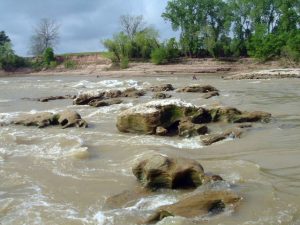Foot entrapment – Catching a foot in rocks on the bottom of the river. May be caused by trying to stand up while getting swept downstream in water mid-thigh to mid-torso deep.
Strainers – Trees or single branches in the current, with river water flowing through, can cause a severe pinning hazard. Strainers many be caused by erosion. Trees can also fall because of old age, floods, and storms. Look for them on wooded riverbanks, along small creeks after high water, often found on the outside of bend, and on less utilized rivers. Always look downstream to spot bobbing twigs or irregular flow patterns.
Man Made Entrapments – Man-made objects in the river are inherently more dangerous than most things natural. Keep an eye out for bridge pilings, low head dams, junked cars, any man made object found commonly in urban riverways, highway crossings, and abandoned dam sites. Make it a habit to visually scan downstream.
Broaches – Getting pinned on a rock, either amidship or at the ends. Avoid sharp rocks that can potentially crease a boat or serve as point to be wrapped by your kayak! Develop the instinct to lean into the rock with your boat and body leaning together.
Undercut Rocks – Undercuts are water features where a slab of rock, or rock shape, forces the current flow to go under the surface. Learn to spot them by the dark shadow on the upstream side of the rock, the lack of pillowing action by oncoming water, and by the lack of a predictable eddy on the downstream side. Most dangerous undercuts are well known by locals, and listed in guidebooks.
Entanglement – Getting tangled exiting your boat is most likely to be caused by ropes, and loose lines, in your boat. Practice wet exits and critically evaluate your outfitting for entanglement potential. Treat throw ropes as potential hazards. Keep them neatly bagged, and carry a knife for rescue.
Vertical Pins – When the bow buries and gets pinned on the bottom after a steep drop. This is not a concern until you are paddling drops of over 3 or 4 feet. Advanced paddlers prevent them by checking the water depth first, and leaning back and performing a ‘boof’ move to keep the bow up. Paddling boats with a large volume bow reduces this risk substantially.
Hydraulics – have evenly formed backwash, water moving back upstream for four or more feet. Holes with more of a wave shape are intimidating, but typically less hazardous than water flowing smoothly upstream. Dams, and hydraulics that are very regular, and perpendicular to the current are far more dangerous than hydraulics angled with one end downstream.
Long Swims – Wearing a tight PFD, matching your ability to an appropriate river, and being dressed for a swim can be excellent defense against a long swim. Another great precaution is a competent group of friends with either a shore or boat based rescue plan.

